Character Creation
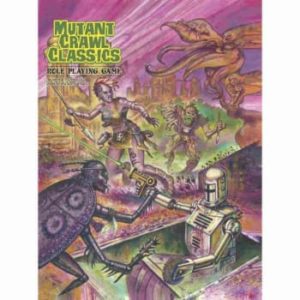
1. Roll ability scores.
2. Adjust ability score modifiers, attack scores, and saving throws.
3. roll 0-level hit points using a 1d4.
4. Roll for beginning profession and equipment, see table below.
5. Roll birth sign
6. Roll twice for additional beginning equipment, table 1-4, Additional equipment may also be obtained by barter.
7. Roll genotype.
8. Determine genotype appearance or sub-type, if any.
9. Choose an archaic alignment.
Ability Scores
Roll 3d6 in order for the following abilities: Strength, Agility, Stamina, Personality, Intelligence, and Luck. Adjust ability derived modifiers as required (see Table 1-1). Though the normal range of ability scores is 3-18, mutations may
increase an ability score to a maximum value of 24.
Hopeless Characters
The environment of Terra A.D. is not only harsh and unforgiving, but genetic birth defects and stillbirths are
common. It is therefore possible to roll up a character who dies during character creation. For example, a character
possessing a 3 Stamina score would then have a -3 modifier to hit points rolled at 0 level, possibly resulting in a negative
hit point total during character creation. Treat this character as having been stillborn, and roll up a new 0 level character.
It is also possible for a 0 level character to start the game severely handicapped by unlucky ability score rolls during
character creation. Judges should encourage players to play even these “1 hp wonders,” as many things can happen to
that character during the course of play – and of such stuff future legends are forged!
Level Zero Occupations: zero level characters can either be Hunter or Gatherers.
Roll D100
1-50 Hunter – Starting Equipment = Wood Spear (1d5)
51-100 Gatherer – Starting Equipment = Large leather Sack
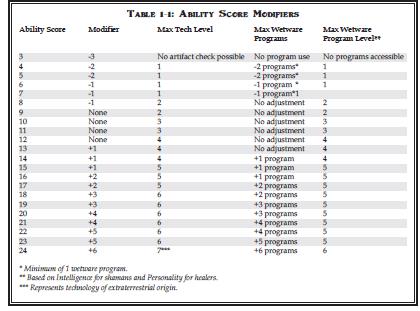
Birth Sign
Each character rolls their birth sign at character creation to determine that character’s “lucky roll.” If a character’s ability scores are such that they have a Luck ability modifier,
then that modifier becomes the character’s inherit lucky roll as determined below. Note that as a character’s Luck
score changes (either up or down), the lucky roll does not change over time.
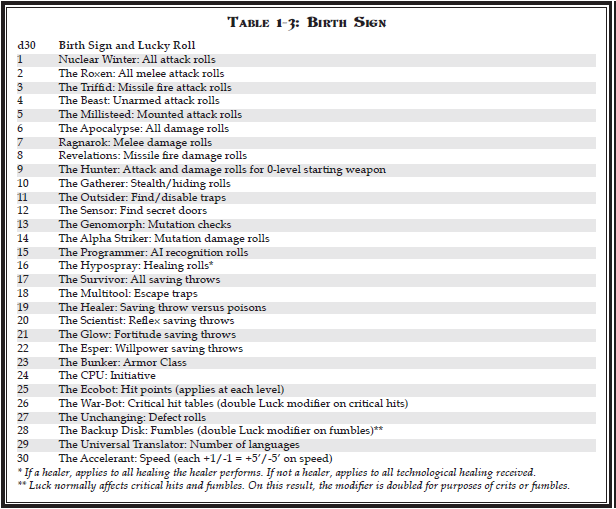
Saving Throws
The MCC RPG uses three saving throws: Fortitude, Reflex, and Willpower. To make a saving throw, a character rolls
1d20, adds his modifier(s), and compares the result to a target number (DC). If the result is equal to or greater than the DC, the save is made. If not, dire effects may ensue. Fortitude represents resistance to physical threats, such as radiation, poisons, gasses, acids, and stunning damage. A character’s Stamina modifier influences his Fort save. Reflex represents resistance to reaction-based threats, such as ducking a swinging robot arm, leaping aside as a ruin collapses, and twisting away from a mutant’s electrical blast. A character’s Agility modifier influences his Ref save. Willpower represents resistance to mind-influencing
threats, such as mutations that charm or control, psychic effects that cause sleep or hypnosis, and mental domination. A character’s Personality modifier influences his Will save. All 0-level characters start with a base modifier of +0 to all saving throws, which is subsequently influenced by their ability modifiers. As characters gain class levels, their saving throws increase.
Languages
All sentient characters know the verbal form of Nu-Speak, a mongrel descendant of the last universal language
spoken by the Ancient Ones. Beginning characters are otherwise illiterate and have no written language.
For each point of Intelligence modifier, characters know one additional language associated with their Archaic Alignment, if any. These additional languages are established at 0 level. Manimals and plantients with Int 8+ automatically know the dialect languages of their general genotype as well. Upon advancing to 1st level, a character may learn additional languages. Rovers learn a secret language called
Security Access. Mutants, manimals, plantients, and other pure strain humans learn one additional language. Shamans
learn one additional language per point of Int modifier. Additional languages that can be learned include those of
specific genotypes and other Archaic Alignments, which all have their own unique cant or jargon. Additionally, shamans may learn programming languages and the guttural tongues of semi-sentient species.
0 Level
All characters start at 0 level. Most will die in the taboo lands, alone, unknown, and unremembered. The fortunate few who so survive will choose a character class in which to advance. In the case of mutants, manimals, and plantients, their race is their character class. As the character earns experience points, his XP total advances. When his XP total reaches 10, he may choose a class. All 0 level characters setting out on their Rite of Passage start out with some additional equipment gifted to them by their clan. Roll twice on Table 1-4 for each 0-level character.
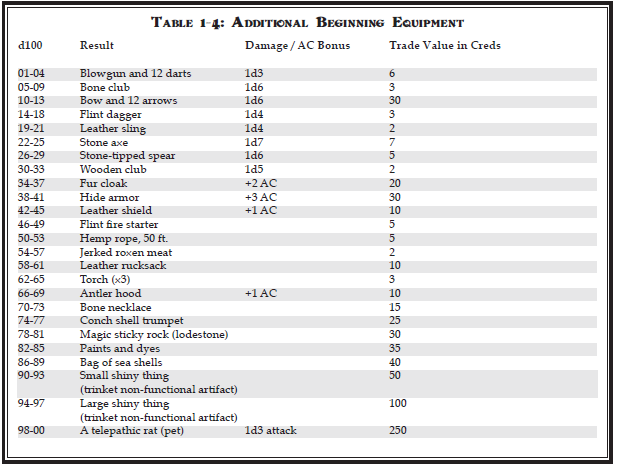
Genotypes
Roll on the genotype table to determine character genotype. Level 0 mutants, manimals, and plantients begin the game with only cosmetic mutations (see below). Additional mutations for these classes manifest at 1st-level, and are rolled for separately at that time.
Roll D100
1-32 – Pure Strain Human
33-66 Mutant – Table 1-6
67-88 Manimal – Table 1-7
89-100 Plantient – Table 1-8
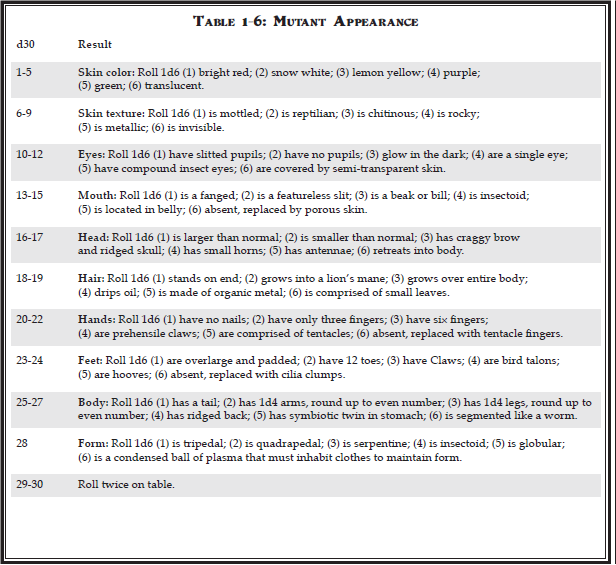
Genotypes Roll on the genotype table to determine character genotype. Level 0 mutants, manimals, and plantients begin the game with only cosmetic mutations. Additional mutations for these classes manifest at 1st level, and are rolled for separately at that time.
Roll D100
1-32 Pure Strain Human
33-66 Mutant (roll on Mutant Table)
67-88 Manimal (roll on Manimal table)
89-00 Plantient (roll on Plantient table)
Mutant Table – Roll D30
1-5 Skin color: Roll 1d6: 1 Bright red, 2 snow white, 3 lemon yellow, 4 purple, 6 green, 6 translucent.
6-9 skin texture: roll 1d6: 1 mottled, 2, reptilian, 3 chitinous, 4 rocky, 5 metallic, 6 invisible.
10-12 eyes: Roll 1d6: 1 slitted pupils, 2 have no pupils, 3 glow in the dark, 4 single eye, 5 compound insect eyes, 6 covered by semi transparent skin.
13-15 Mouth: Roll 1d6: 1 fanged, 2 featureless slit, 3 beak or bill, 4 instectoid, 5 located in belly, 6 absent, replaced by porous skin
16-17 head: Roll 1d6: 1 larger than normal, 2 smaller than normal, 3 craggy brow ad ridged skull, 4 small horns, 5 antennae, 6 retreats into body.
18-19 hair: roll 1d6: 1 stands on end, 2 grows into a lion’s maine, 3 grows over entire body, 4 drips oil, 5 metallic, 6 made of leaves.
20-22 hands: roll 1d6: 1 have no nails, 2 have only three fingers, 3 have six fingers, 4 are prehensile claws, 5 are comprised of tentacles, 6 absent, replaced with tentacle tentacle fingers
23-24 feet: roll 1d6: 1 overlarge and padded, 2 have 12 toes, 3 have claws, 4 bird talons, 5 hooves, 6 absent, replaced with cilia clumps.
25-27 body: Roll 1d6: 1 has tail, 2 has 1d4 arms round to even numbers, 3 has 1d4 legs, round up to even number, 4 has ridged back, 5 has symbiotic twin in stomach, 6 segmented like a worm.
28 Form: Roll 1d6: 1 tripedal, 2 quadrapedal, 3 serpentine, 4 instectoid, 5 globular, 6 condensed ball of plasma that must inhabit clothes to maintain form.
29-30 roll twice on table
Manimal Table – Roll d30
1-4 Primate: Roll 1d4 1 = gorilla, 2 = chimpanzee, 3 = orangutan, 4 = gibbon
5-8 Canine: Roll 1d4 1= dog, 2 = wolf, 3 = coyote, 4 = fox
9-11 Feline: Roll 1d4 1 = lion, 2 = tiger, 3 = cheetah, 4 = panther
12-13 Ursine: Roll 1d3 1 = brown bear, 2 grizzly bear, 3 polar bear
14-16 Bovine: Roll 1d5 1 = cow, 2 bison, 3 = buffalo, 4 = antelope, 4 = yak
17-18 Suidae: Roll 1d3 1 – pig, 2 = hog, 3 = warthog
19-20 Rodentia: Roll 1d6 1 = mouse, 2 = rat, 3 = squirrel, 4 = porcupine, 5 = beaver, 6 = rabbit
21-22 Amphibia: Roll 1d3 1 = frog, 2 = toad, 3 = salamander
23-24 Avian: Roll 1d6 1 = hawk, 2 = eagle, 3 = crow, 4 = owl, 5 = vulture, 6 = seagull
25-27 Insecta: Roll 1d6 1= roach, 2 = ant, 3 = fly, 4 = grasshopper, 5 = beetle, 6 = moth
28-30 Roll again on this table, then roll on mutant appearance table
Plantient Sub-Type – Roll d30
1-5 Deciduous: Roll 1 d5 1 = maple, 2 = oak, 3= sycamore, 4 = buckeye, 5 = chestnut
6-9 Conifer: Roll 1d6 1 = cedar, 2 = larch, 3 = fir, 4 = pine, 5 = spruce, 6 = yew
10-11 Fruit Bearing: 1d6 1 = apple, 2 = pear, 3 = peach, 4 = cherry, 5 = plum, 6 = banana
12-13 Fern: Roll 1d3 1 = horsetail, 2 = whisk fern, 3 = marratoid
14-16 Vine: Roll 1d6 1 = Ivy, 2 = honeysuckle, 3 = arrowroot, 4 = morning glory, 5 = grape, 6 = sweet pea
17-19 Shrub: Roll 1d6 1 = sagebrush, 2 = hibiscus, 3 = blackberry, 4 = huckleberry, 5 = sumac, 6 = yucca
20-22 Tropical: Roll 1d4 1 = palm, 2 – coconut, 3 = bamboo, 4 = teak
23-24 Cacti: Roll 1d4 1 = barrel, 2 = beavertail, 3 = aloe, 4 = prickly pear
25-27 Mosses: Roll 1d3 1 = green moss, 2 = liverwort, 3 = hornwort
28-29 Fungi: Roll 1d4 1 = mushroom, 2 = toadstool, 3 = fungus, 4 = mold
30 roll again on this table, then roll on mutant appearance table
Archaic Alignment
All 0 level genotypes may begin as members of The Clan of Cog. Optionally, pure strain humans may instead choose to be members of The Curators. Mutants may opt to become members of The Children of the Glow. Manimals may follow The Chosen Zuu. While plantients may choose to be members of the Atomic Equinox instead.
Rite of Passage
All characters being as 0 level members of their tribe or village with an occupation of hunter or gatherer. Until undergoing the Rite of Passage, they are considered sub adults by their kinsmen (No matter how chronologically old). The details of the rite vary from tribe to tribe, but typically involve going out into the wilderness in small groups, surviving for 7-10 days, and returning to the tribe with an artifact of ancients in working order. For mutants, manimals, and plantients, it is also expected that the stress of undergoing the Rite of Passage will also trigger the Meta-genesis, i.e the blossoming and full expression of their inherited mutant DNA.
While it is considered a symbol of great status among the tribes for Rite of Passage participants to brave the hot house jungles and radioactive deserts of Terra A.A. with no more than a flint and dagger, a water skin, and a few days of jerked roxen meat, there is no limit on what may be taken along and no shame in doing so. Dead members of a tribe , no matter how young or inexperienced, are of little use to anyone, so participants may take with them any items that can be scavenged together, be it their deceased uncle’s stone axe, the odd piece of starting equipment, or items for which they have traded.
The Life of a Seeker
Since status as an adult within a tribe is primarily determined by the quality and type of artifact that is returned to the tribal chieftains, it is likely that very successful survivors of the Rite of Passage will be assigned the plumb role of tribal Seeker. While there is no shame in returning from the rites with a working ancient beverage container or small scarp of durally, those who do so tend to be later given the relatively mundane adult tasks of simply continuing to do hunting and gathering for the tribe. The exceptional character who returns with an actual working artifact of the ancients will find themselves rightly assigned the job of seeker – an elite group of tribesmen assigned to roam the wilderness and retrieve valuable lost technology for the benefit of their tribe. Since a seeker may select anyone he deems useful to be a part of his or her Seeker team, it is thus possible for all player characters who survive the Rite of Passage to eventually become Seekers.
Level Advancement
As a character completes adventures, he practices his skills and becomes more talented. Characters earn experience points (xp) that allow them to progress in level.
Each encounter is worth from 0 – 4 xp and those xp are not earned merely by killing monsters, disarming traps, looting artifacts, or exploring a ruin. Rather, successfully surviving encounters earns the characters xp. A typical encounter is worth 2 xp but scales up or down based on difficulty.
The judge determines how much xp is awarded.
Characters level up when they reach the xp threshold for the next level
The level thresholds become progressively higher. The number of average adventures required to advance to teach subsequent level is higher than the preceding level.
Level Thresholds
0 = 0 xp
1 = 10 xp required
2 = 50 xp required
3 = 110 xp required
4 = 190 xp required
5 = 290 xp required
6 = 410 xp required
7 = 550 xp required
8 = 710 xp required
9 = 890 xp required
10 = 1090 xp required
Hit Points: A 1st level character retains his hit points form level 0, and gains new hit points according to his class. All characters of 1st level or higher thus have their class hit dice plus 1d4 hit points from level 0
Choosing a Class
In many cases, the choice of character class will be dictated by the genotype of the player character. For mutants, manimals, and plantients, their genotype is their character class – the two terms are synonymous. For pure strain humans, the unknowing descendants of the longest – evolved and most adaptable genotype, the rise from 0 – level hunter-gatherer to seeker means specializing in one of four separate character classes for pure strain humans, or three race as class for mutants, manimals, and plantients.
Hit Points: Each class uses a certain die to determine hit points. Note that all characters receive 1d4 hit points at 0 level, and their class hit points are in addition to the 1d4 hit points from 0 level.
Weapon Training: all classes are considered to be equally adept with any and all primitive weaponry.
Action Dice: Action dice are used to make attacks, use mutations, execute wetware programs. The most common use of an action die is to attack, most characters roll 1d20 for their attack rolls because they have 1d20 action die. As characters advance in level, they may gain additional action dice. Typically, these start as additional dice of lower facings to reflect that the character’s secondary attacks are not as effective as his primary attacks. Character classes with mutations or wetware program use may be able to use action dice to make additional attacks, as described in the class descriptions.
Title: Titles are included for characters of levels one through six. These titles reflect the most common terms for characters of that power level. Characters of 7th level and above are extremely rare, so much so that no generic titles exist. Players are encouraged to develop their own titles for such levels.